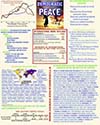[First published March 15, 2006] So far, there is considerable empirical support for the argument that promoting global freedom, if successful, will make the world generally more peaceful, and possibly end war and democide. However, there has been little empirical work that bears specifically on terrorism in the context of the democratic peace. So, I will do that here.
A relevant scale for doing this is the Purdue Political Terror Scale (PTS) shown below. It attempts to measure the degree to which governments terrorize their citizens and deprive them of human rights.

Mark Gibney and Mathew Dalton developed the Political Terror Scale. An article on it, plus “Political Terror Scale Notes” and the actual scoring on it each year for all nations, 1980-2004 is available on Gibney’s personal website . He is Belk Distinguished Professor and Professor of Political Science at the University of North Carolina Ashville.
I know, I know, this is not the terrorism that is focused on today, which is that of small groups of terrorists, their murder and genocide bombing, and their insurrections. But, behind it all are level 4 or 5 PTS states, such as Iran, Syria, and North Korea, as were Fatah’s Palestine Authority, Saddam’s Iraq, and the Taliban’s Afghanistan. Democratize these states and individual and group terrorism will dry up for want of resources and bases, at least as implied by the Forward Strategy of Freedom. But, we’ll see.
The PTS scale values for all nations were coded from the annual Amnesty International (AI) and United States State Department (State) Country Reports on Human Rights. Because of these sources, Oona A. Hathaway and Daniel E. Ho used the PTS scale for “Characterizing Measurement Error in Human Rights.” (CME — in pdf): They say:
We illustrate a method for accounting for measurement error in human rights studies — an area of research plagued by difficulties of measuring concepts that cannot be directly observed. We focus on the widely used Purdue Political Terror Scales (PTS), which quantify political terror experienced in a country based on independent qualitative narrative reports compiled by the United States Department of State and Amnesty International. A simple Bayesian measurement model systematically incorporates these two independent codings and directly models the uncertainty of a latent measure of political terror. This reveals that attenuation bias due to lagged PTS estimates can be severe, leading conventional estimates to be conservatively biased by an absolute order of roughly two. Substantively, this means that explanatory variables such as democracy may have roughly twice the impact on human rights as currently believed. We conclude that measurement methods illustrated here hold much promise for addressing concerns about measurement error in empirical scholarship. [Bold italics added]
As to the two politically antagonistic sources — State and AI — the above CME report finds that the correlation between them across all the countries in their report is .83, which means that in their reporting of human rights these two sources are at variance across 31 percent of the data (1-correlation squared).
CME shows the variation of these two sources in the chart below:

Now, my empirical question is this: How well does the degree of liberal democracy of a nation predict its scale level on the PTS, which is to say, terrorism and lack of human rights. I took the PTS values for 2004 and the Freedom House freedom ratings for the same year on both civil liberties and political rights, where the lower the average rating on both, the more liberal democratic a nation. Then, I did a bivariate regression, and found that the degree of freedom predicted 32% of the variation in terror/human rights (R squared = .32, a very conservative finding, given the CME conclusion about democracy and human rights given above). That is, the more liberal democratic a nation, the less its government terror and the more its government respects human rights [PTS = 1.51-27(Freedom rating); signs on both scales reversed].
Since the relationship may not be linear, I should note that the analysis of variance is very good (F-stat = 81.6, p <.0001) In my next post, I’m going to explain what this sometimes mysterious “p” that appears in so many quantitative studies means, and its pitfalls. Just take my word today that “p” here is not a sampling probability (it cannot be since I am dealing with all countries and not a sample in any meaningful statistical sense), but a combinatorial one.
Anyway, my plot of the two is shown below, where -HR is the reversed PTS, and the X-axis is the reversed freedom ratings. For -HR, 1 is the most terroristic nations with the least human rights, and 5 reverses this; for the -FREE average ratings, 1 is the least free, 7 the most. Thus, as one moves to the right on the X-axis and up on HR (PTS) Y-axis, the greater the freedom, and the less the terror and the more respect for human rights.

Obviously, there is considerable variation around a trend of decreasing terror/increasing human rights as freedom increases. To see this, I averaged the PTS scores for each freedom rating. I show the result in the plot below, where the axes are the same as above (sorry, the X-axis label is cut off).

The bottom line should be clear. To eliminate the terrorism of governments against their people and guarantee their human rights, foster democratic freedom.And this is now the American foreign policy, which judging by all the empirical analyses that support it, is one of realistic idealism.







